
Scaremongering at its best
A perspective on potential climate changes presented by Dr. Robert B. Gagosian,
President and Director of Woods Hole Oceanographic Institution
Over the past two decades, we have heard about greenhouse gases and the idea that our planet is gradually warming. I'd like to throw a curveball into that thinking—specifically the "gradually warming" part.
This new thinking is little known and scarcely appreciated by policymakers and world and business leaders—and even by the wider community of natural and social scientists. But evidence from several sources has amassed and coalesced over the past 10 to 15 years. It points to a completely different—almost counterintuitive—scenario.
Global warming could actually lead to a big chill in some parts of the world. If the atmosphere continues to warm, it could soon trigger a dramatic and abrupt cooling throughout the North Atlantic region—where, not incidentally, some 60 percent of the world's economy is based.
When I say "dramatic," I mean: Average winter temperatures could drop by 5 degrees Fahrenheit over much of the United States, and by 10 degrees in the northeastern United States and in Europe. That's enough to send mountain glaciers advancing down from the Alps. To freeze rivers and harbors and bind North Atlantic shipping lanes in ice. To disrupt the operation of ground and air transportation. To cause energy needs to soar exponentially. To force wholesale changes in agricultural practices and fisheries. To change the way we feed our populations. In short, the world, and the world economy, would be drastically different.
And when I say "abrupt," I mean: These changes could happen within a decade, and they could persist for hundreds of years. You could see the changes in your lifetime, and your grandchildren's grandchildren will still be confronting them.
And when I say "soon," I mean: In just the past year, we have seen ominous signs that we may be headed toward a potentially dangerous threshold. If we cross it, Earth's climate could switch gears and jump very rapidly—not gradually— into a completely different mode of operation.
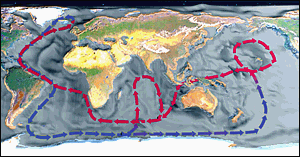 |
|
| A schematic of the ocean circulation system, often called the Great Ocean Conveyor, that transports heat throughout the world oceans. Red arrows indicate warm surface currents. Blue arrows indicate deep cold currents. |
The key to these climate shifts is that Earth's climate is created and maintained by a dynamic system of moving, interacting parts. Earth's climate system has two main components. The first one you are all familiar with by watching your local TV meteorologist or The Weather Channel. It is the atmosphere, which circulates heat and moisture around the globe. But, in fact, the atmosphere redistributes only about half of the energy that the earth receives from the Sun.
The other half is transported around our planet by a circulation system that is equally important, but far less understood—the ocean. The ocean isn't a stagnant bathtub. It circulates heat around the planet like the heating and cooling system in your house. The atmosphere and oceans are equal partners in creating Earth's climate. The atmosphere is a rabbit. It moves fast. Rapid changes in atmospheric circulation cause storms, cold spells, or heat waves that play out over several days.
The ocean, on the other hand, is a turtle. It may take years or decades or even millennia for similar "disturbances" to circulate through the ocean. But the ocean is a big turtle. It stores about 1,000 times more heat than the atmosphere. So changes in ocean circulation can set the stage for large-scale, long-term climate changes.
One example that you may be familiar with is El Niño. Every few years, oceanic conditions shift, and surface water temperatures in the eastern tropical Pacific get warmer. The atmosphere above the ocean shifts, too. El Niño rearranges worldwide wind and rainfall patterns, causing destructive droughts, floods, storms, and forest fires. Not to downplay El Niño in the least, because it causes grave human suffering and billions of dollars in damage—but El Niño is relatively short-lived. It lasts only a year or two.
The climate changes I'm concerned about last longer and involve the ocean circulation system that spans the entire globe—which we often call the Great Ocean Conveyor.
The Great Ocean Conveyor is the ocean's major heat-circulating system. The ocean keeps our planet from overheating by transporting heat north and south, from the equator to the poles, in currents traveling near the ocean surface. In the Atlantic, the Conveyor removes heat from the Southern Hemisphere and releases it to the Northern Hemisphere.
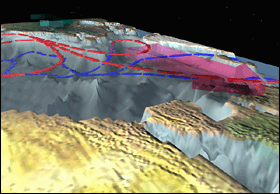 |
|
| The Great Ocean Conveyor is propelled by the sinking of cold, salty (and therefore denser) waters in the North Atlantic Ocean (blue arrows). That creates a void that pulls warm, salty Gulf Stream waters northward (red arrows). The Gulf Stream gives up its heat to the atmosphere above the North Atlantic Ocean, and prevailing winds (large red arrows) carry the heat eastward to warm Europe. |
When the Gulf Stream's warm, salty waters reach colder latitudes, they give up their heat to the atmosphere. The atmosphere in the North Atlantic region warms by as much as 10 degrees Fahrenheit. Prevailing winds carry the heat eastward into Europe. That's one reason London, England—which is located at the same latitude as Calgary and Edmonton—has warmer winters than New York—which is hundreds of miles farther south.
When the Gulf Stream's waters reach the Labrador, Greenland and other northern seas, and lose their heat to the atmosphere, they become colder—and hence denser. The waters are also relatively salty. Salty water is denser than fresher water, so the whole salty mass begins to sink to great depths.
When this sinking mass of cold water reaches the abyss, it then flows at deep levels of the ocean, from the North Atlantic southward into the South Atlantic. The plunge of this great volume of cold, salty water propels the Great Ocean Conveyor. And on the back end, it creates a void that actively pulls the Gulf Stream northward to replace the waters that are sinking.
It's a pretty neat system. We have been operating under the climate conditions created by this beneficent oceanic heating, ventilation, and cooling system for centuries.
But what if this system weren't operating today? What if cold North Atlantic waters didn't sink and warm equatorial waters weren't drawn in to replace the sinking waters? Then the North Atlantic region would be a much different, much colder place.
The vast majority of us go about our business thinking that Earth's climate system has always been this way, and always will be. But that is just not the case. In fact, we know that the Ocean Conveyor has indeed shut down—stopped operating—in the past.
We know this by examining truly interesting and valuable natural archives that record past changes in Earth's climate. For example, we can see layers within ice sheets in Greenland or in high elevations in the Andes Mountains in South America. This layering is caused by variations in the amount of snow that fell on the top of the ice sheet in the past.
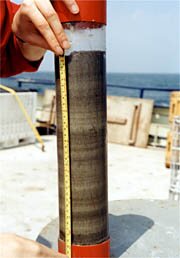 |
|
| Top: Ice sheets reveal annual layers, which scientists can analyze to reconstruct the history of precipitation and air temperatures 100,000 years in the past. (Photo by Lonnie Thompson, Ohio State University) Bottom: Cores of seafloor sediments reveal the climate history of the ocean. (Photo by Ken Buesseler, WHOI) |
Thus from a single ice sheet record, it is possible to reconstruct the past history of precipitation and air temperature in a region. For very old ice sheets, like the glaciers on Greenland, it is possible to reconstruct this climate history 100,000 years into the past.
The ocean has similar archives of past climate. By taking cores from the ocean floor, it is possible to reconstruct the history of ocean climate back many thousands of years. We have used our ships to collect samples of sediments from the seafloor. Preserved in the sediments are the fossil remains of microscopic organisms that settle to the seafloor. They accumulate over time in layers—similar to the ice core—that delineate many important aspects of past climate.
For instance, certain organisms are found only in colder, polar waters and never live in warmer waters. They can reveal where and when cold surface waters existed—and didn't exist—in the past.
From records like these, we know that about 12,800 years ago, North Atlantic waters cooled dramatically—and so did the North Atlantic region. This large cooling in Earth's climate occurred in about a decade. And the cold spell lasted for about 1,300 years.
This period is called the Younger Dryas, and it is just one of several periods when Earth's climate changed very rapidly from warm to cold conditions, and then back to warm again. So these long-term cold snaps are not unusual.
These shifts almost certainly involved changes in the ocean's circulation. There were shutdowns and restartings of the Ocean Conveyor. These warm-to-cold transitions happen in about 3 to 10 years. The cold periods lasted for 500 to 1,000 years. Such oscillations in temperature and ocean circulation have occurred on a regular basis.
About 1,000 years ago, during a period of unusually warm temperatures in the North Atlantic, the Norse established settlements and vineyards in Greenland that would not be possible today. Those settlements were abandoned about 500 years ago, when we believe the most recent shutdown of the North Atlantic Ocean circulation system occurred.
During that era, called the Little Ice Age, northern Europe was much colder than it is today. Glaciers spread outward and downward in the Alps. Winters, on average, were more severe. Farming was affected. Famine was frequent.
In the 1730s and 1740s, abrupt European cooling caused famine across western Europe, especially in Ireland and France, where farmers depended on wheat and potatoes. In Ireland, this is known as the "forgotten famine." As many people died during the forgotten famine as died during the famed potato famine of the 1840s.
The 16th-century Flemish artist Bruegel couldn't have painted his famous frozen landscapes today, because now canals in the Netherlands rarely freeze, as they regularly did back then. And likewise, the winter in Valley Forge might not have been so cold, and Washington's crossing of the ice-bound Delaware River wouldn't have been so dramatic, if he had done it a century later—because our climate conditions have shifted since then, and today, the Delaware River rarely freezes.
If you read David McCullough's biography of John Adams, you will remember that the British were about to set Boston on fire when George Washington was able to bring the cannons of Fort Ticonderoga down from upstate New York in record time. He was able to do it because the ground was frozen solid and they could slide the cannons to the Dorchester hills of Boston in time to persuade the British to retreat from Boston and to change the course of history.
So we have solid evidence that the Great Ocean Conveyor has slowed down or shut down in the past. And we have seen dire impacts on our climate. It begs the question: Could something throw a wrench into the Great Ocean Conveyor in the near future? And could that trigger abrupt, dramatic climate changes throughout our planet? The answers to those questions are, indisputably, "Yes and yes."
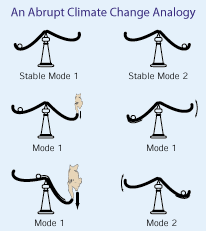 |
|
| Like most dynamic systems, Earth's climate seeks a stable mode (top tier). If the system is pushed, it will stagger for a while unitl it recovers (middle tier). If it is pushed past a threshold, it will shift into another mode of operation (bottom tier). (Illustration by Jack Cook, WHOI, adapted from Abrupt Climate Change, Inevitable Suprises National Research Council) |
The middle tier shows what happens if you push on the system. The ball will rattle and roll around in different directions for a while until it settles back down in its cup. We humans would definitely notice that rattling until the climate system returned to equilibrium. The balance, forced to move, staggers but recovers.
Then there is a third situation— in which a strong enough push at the right time could shove the system past a threshold and into a completely different mode of operation. In terms of our climate system, that means that a small or temporary forcing could produce a sudden, large, and long-lasting change. That begs the next question: What could do that to our climate system today?
One answer to that is fresh water. If you simply add too much fresh water to the North Atlantic, the waters there will become less salty and less dense. They will stop sinking. Then the Gulf Stream slows down or is deflected southward. Winters in the North Atlantic region get significantly colder.
Now here's the predicament. In the past year, oceanographers monitoring and analyzing water conditions in the North Atlantic, have concluded that the North Atlantic has been freshening dramatically—especially in the past decade. New data —from Ruth Curry at Woods Hole Oceanographic Institution and her colleague Robert Dickson at the British Centre for Environment, Fisheries, and Aquaculture Science—chronicles salinity changes in the western North Atlantic since 1960.
The Great Ocean Conveyor transports fresh surface water down into the depths. The depths can absorb a lot of fresh water like a sponge. But since 1970, the equivalent of an extra 20 feet of fresh water across the surface of the northern North Atlantic has been transported down into the ocean depths, most of that since 1990.
A sponge that is three-quarters saturated can still absorb more water. But the moment that sponge is fully saturated, it can absorb no more water.
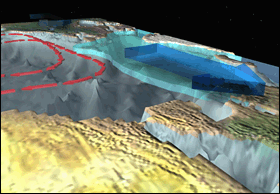 |
|
| If too much fresh water enters the North Atlantic, its waters could stop sinking. The Great Conveyor would cease. Heat-bearing Gulf Stream waters (red arrows would no longer flow into the North Atlantic, and winters would become more severe. |
The very recent freshening signal in the North Atlantic is arguably the biggest and most dramatic change in ocean property that has ever been measured in the global ocean. Already, surface waters in the Greenland Sea are sinking at a rate 20 percent slower than in the 1970s.
At what percent will the Ocean Conveyor stop? 25 percent? 40 percent? 60 percent? This is not like a dimmer switch, but more like a light switch. It probably goes from "on" to "off."
We can't yet determine the precise source or sources of this additional fresh water. Global warming may be melting glaciers, or Arctic sea ice. In recent decades, the volume of Arctic sea ice has decreased by 40 percent. And if North Atlantic sinking slows down, less salty Gulf Stream waters flow northward—which exacerbates the situation.
In February 2002, at a worldwide meeting of oceanographers, new data on North Atlantic freshening prompted many scientists to say that salinity levels in the North Atlantic are approaching a density very close to the critical point at which the waters will stop sinking.
One of my colleagues at Woods Hole, Terry Joyce, put it this way: "I'm in the dark as to how close to an edge or transition to a new ocean and climate regime we might be," he said. "But I know which way we are walking. We are walking toward the cliff."
To that sentiment, I would add this: We are walking toward the edge of a cliff—blindfolded. Our ability to understand the potential for future abrupt changes in climate is limited by our lack of understanding of the processes that control them.
 |
| New data shows that North Atlantic waters at depths between 1,000 and 4,000 meters are becoming dramatically less salty, especially in the last decade. Red indicates saltier-than-normal waters. Blue indicates fresher waters. Oceanographers say we may be approaching a threshold that would shut down the Great Ocean Conveyor and cause abrupt climate changes. (Data from Ruth Curry, WHOI, Bob Dickson, Centre for Environment, Fisheries, and Aquaculture Science and Igor Yashayaev, Bedford Institute of Oceanography) |
In the past decades, we have made great strides in understanding Earth's atmospheric circulation system because we established a global network of thousands of meteorological stations to monitor changing atmospheric conditions. No observational network exists to continuously monitor the oceans. If we just had a few more strategically placed modern instruments in the oceans for an extended time, we could understand so much more about how the oceans can cause abrupt climate changes. At present, there is no national plan for improving our understanding of the issue, and according to a 2002 National Research Council report, no policymaking body is addressing the many concerns raised by the potential for abrupt climate change.
So here's the situation: We have unequivocal evidence of repeated, large, widespread, abrupt climate changes on Earth. It is reasonable to assume that greenhouse warming can exacerbate the possibility of precipitating large, abrupt, and regional or global climatic changes. We even have strong evidence that we may be approaching a dangerous threshold—that we are squeezing a trigger in the North Atlantic.
We could downplay the relevance of past abrupt events and deny the likelihood of future abrupt climate changes. But that could prove costly. With growing globalization, the adverse impacts of climate changes are likely to spill across national boundaries—through migration, economic shocks, and political aftershocks.
Over human history, one of the major ways that humans have adapted to changing environmental and economic fortunes has been to migrate from unproductive or impacted regions to more productive and hospitable regions. But today, the world's population has grown too large. There is less usable, unpopulated territory to absorb migrants. National borders are less open, so it is difficult for people to move to other countries when droughts, floods, famines, and wars occur. These boundary effects could be particularly severe for small and poor countries, whose populations are often unwelcome in richer countries. In the 1840s, more than 1 million Irish people emigrated because of the potato blight. Can you imagine an equivalent migration of many millions of people today? Keep in mind that there were only about 1 billion people on Earth then. There are 6 billion now.
As a society, I believe we must face the potential for abrupt climate change. Perhaps we can mitigate the changes. If not, at least we can still take steps to adapt to them.
The best way to improve the effectiveness of our response is to have more knowledge of what can happen—and how and when. Research into the causes, patterns, likelihood, and effects of abrupt climate change can help reduce our vulnerabilities and increase our ability to adapt.
If climate changes come abruptly, we will have less time to adjust. In other words, the more knowledge we have—the more reliably we can predict changes—the better our chances.
Maybe over the edge of the cliff, there's just a three-inch drop-off. Or maybe there's a big, fluffy bed full of pillows. My worry is that we are indeed approaching this cliff blindfolded.
Are you comfortable and secure with this scenario?

FAEC's Comment: Well, yes, we feel quite comfortable and secure, because that scenario does not exist. The favorite scenario of certain climate modelers, as Mr. Gagosian's, is one in which the North Atlantic oceanic “conveyor belt” and Gulf Stream are turned off, thereby turning Western Europe into Siberia. But more realistic models show that the warmer European temperatures are not set by the Gulf Stream but by the perturbation of the atmospheric circulation induced by the Rocky Mountains of the Western US [Seager, Richard. 2003. Quart. J Royal Meterorol. Soc]. Another model shows that even as there is a freshening of the North Atlantic, the conveyor belt is strengthened not weakened: Read the abstract:
http://www.agu.org/pubs/crossref/2004/2003GL018584.shtml
GEOPHYSICAL RESEARCH LETTERS, VOL. 31, L02301, doi:10.1029/2003GL018584, 2004
Does the recent freshening trend in the North Atlantic
indicate a weakening thermohaline circulation?
Peili Wu, Richard Wood, and Peter Stott
Met Office, Hadley Centre for Climate Prediction and Research, United Kingdom
Abstract
[1] It is widely expected that the thermohaline circulation of the ocean will slow down as greenhouse gas concentration in the atmosphere increases. This is partly due to an intensified hydrological cycle in a warmer climate. Is the recent observed freshening trend in the North Atlantic an indication of what has been expected? We report a similar freshening trend reproduced in an ensemble of four coupled model simulations with all major historical external (natural and anthropogenic) forcings. The modeled freshening trend originates from the Arctic Ocean where sea ice decrease and river runoffs increase with the same trend. Instead of weakening, we find an upward trend in the North Atlantic meridional overturning circulation.
Received 9 September 2003; accepted 3 December 2003; published 20 January 2004.
Finally, we have the direct evidence from the atmosphere: Previous warmings, the Holocene optimum (8000-5000 BP) and the Medieval Climate Optimum (ca. 1000 AD), did not cause any abrupt cooling. So much for Gagosian's dreams.